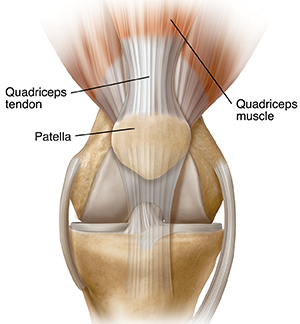Quadriceps Tendon Rupture
A tendon is a thick cord that connects muscle to bone. When a tendon tears, the muscle can’t work correctly. You have a tear (rupture) in the quadriceps tendon. This tendon connects the thigh’s main muscles (the quadriceps) to the kneecap (patella). It helps to straighten the knee from a bent position. When the quadriceps tendon tears, it becomes hard to straighten the knee, and hard to walk.

A quadriceps tendon rupture is often a sports-related injury. It may occur after landing very hard from a high jump, or after suddenly changing direction when running fast. The injury can also be due to a fall, a deep cut (laceration), or a direct blow to the front of the knee. A tear is also more likely to occur if the tendon is weak. This can be caused by a long-term (chronic) disease, certain medicines, tendonitis (inflammation), or being on bed rest.
A tear can be partial or complete. A partial tear means the tendon is damaged, but still intact. A complete tear means the tendon has split into 2 pieces. Or the quadriceps tendon may be separated from the kneecap.
You may have felt a sharp pain in your knee when this injury occurred, along with a popping and a feeling of something tearing in your knee. You may also have pain, swelling, and bruising in the knee area. You likely have trouble straightening your knee and walking. If it’s a complete tear, you may also feel a small gap or space just above your kneecap.
X-rays and an MRI scan may have been done.
Treatment will depend on whether you have a partial or complete tear. A partial tear can often heal without surgery. Treatment often includes wearing a brace or a knee immobilizer for 3 to 6 weeks, as well as physical therapy. You may need to use crutches to keep weight off the affected leg. For large partial tears or complete tears, surgery is done to fix the tendon and reconnect it to the kneecap.
You’ll be advised to see an orthopedic surgeon. This is a doctor with special training to treat bone and muscle problems. The surgery should be done soon after the injury. In most cases, your knee will be kept in full extension for several weeks after surgery. Talk with your surgeon about specific instructions on range of motion. You’ll also need physical therapy. Recovery after surgery takes about 4 to 6 months. It may take up to 12 months to fully regain strength and knee motion in the injured leg.
Home care
Medicine
Your healthcare provider may prescribe medicines for pain. Or you may use acetaminophen or ibuprofen to control the pain. Talk with your provider before taking these medicines if you have chronic liver or kidney disease. Also talk with your provider if you’ve had an ulcer or gastrointestinal bleeding.
General care
Follow these guidelines when caring for yourself at home:
-
Rest. Use crutches as needed. Don't put any weight on the injured leg until your healthcare provider says it’s OK.
-
Ice. Put a cold pack on the injured area for 20 minutes at a time. Do this at least 4 to 8 times a day for the first 48 hours. After the first 48 hours, use the cold pack to ease pain and swelling, as needed. To make a cold pack, put ice cubes in a plastic bag that seals at the top. Wrap the bag in a thin towel or cloth before using it. Don’t put a cold pack directly on your skin.
-
Compression. The healthcare provider may give you an elastic wrap to help ease swelling. Use this as the provider tells you to.
-
Elevate your leg. During the first 48 hours, keep your injured leg raised (elevated) on a pillow when you’re sitting or lying down. The pillow should be at a level above your heart. This is helpful to reduce swelling.
Follow-up care
You may be referred to an orthopedic doctor to evaluate your injury and possibly repair it. Surgery may be needed to repair this injury. So it’s important to make an appointment with the specialist as soon as you can.
If X-rays or an MRI scan were taken, you’ll be told of any new findings that may affect your care.
When to get medical advice
Call your healthcare provider if any of these occur:
-
Fever of 100.4°F (38°C) or higher, or as advised by your provider
-
Chills
-
Pain or swelling gets worse, or redness appears